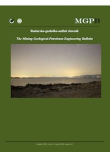Volume based closed-cycle Hardgrove grindability method
DOI:
https://doi.org/10.17794/rgn.2019.4.2Keywords:
Universal Hardgrove mill, Bond index, grindability, specific grinding work, closed-cycle grinding.Abstract
This paper deals with the development of a volume based closed-cycle grindability test method based on the recently introduced Universal Hardgrove mill and procedure. Five model materials with various origin and material characteris- tics (hardness, grindability, heterogeneity) were chosen for the experiments, i.e. limestone, quartz, andesite, basalt and cement clinker. The grindability of the material was characterized simultaneously in four various ways: 1) the standard Hardgrove Grindability test (HGI), 2) Bond work index calculated from HGI, 3) the conventional Bond test and 4) the closed-cycle volume based grindability test in the Universal Hardgrove mill. The grindability coefficient (G), and the cumulative particle size distribution of 80% passing size (x80) of the product of the closed-cycle Hardgrove test were determined. Relative deviation of the above parameters was very good (in most cases lower than 3%) which indicates the new proposed method as a robust procedure for rapid determination of specific grinding energy of closed cycle grinding in ring mills. Therefore, this test is able to ease the optimization of grinding conditions relatively fast and reliably.
Downloads
Published
How to Cite
Issue
Section
License
Copyright (c) 2019 authors and journal

This work is licensed under a Creative Commons Attribution 4.0 International License.
Creative Commons-BY
Authors who publish with this journal agree to the following terms:
In agreeing this form, you certify that:
- You read the ethical codex of the RGN zbornik available at journal web.
- You submitted work is your original work, and has not previously been published and does not include any form of plagiarism.
- You own copyright in the submitted work, and are therefore permitted to assign the licence to publish to RGN zbornik.
- Your submitted work contains no violation of any existing copyright or other third party right or any material of an obscene, libellous or otherwise unlawful nature.
- You have obtained permission for and acknowledged the source of any illustrations, diagrams or other material included in the work of which you are not the copyright owner.
- You have taken due care to ensure the accuracy of the work, and that, to the best of your knowledge, there are no false statements made within it.
- All co-authors of this submitted work are aware of, and in agreement with, the terms of this licence and that the submitted manuscript has been approved by these authors.
Publication licence
You retain copyright in your submitted work, according to journal license policy (CC-BY). By signing this form you agree that RGN zbornik may publish it under the publication licence. In summary the licence allows the following:
Anyone is free:
- To copy, distribute, display, and perform the work.
- To make derivative works.
Under the following conditions:
- The original author must always be given credit.
- The work may not be used for commercial purposes.
- If the work is altered, transformed, or built upon, the resulting work may only be distributed under a licence identical to this one.
Exceptions to the licence
In addition to publishing the work printed under the above licence, RGN zbornik will also enable the work to be visible online.
The journal editorial can change the licence rules anytime but it cannot retroactively restrict author(s) rights.


